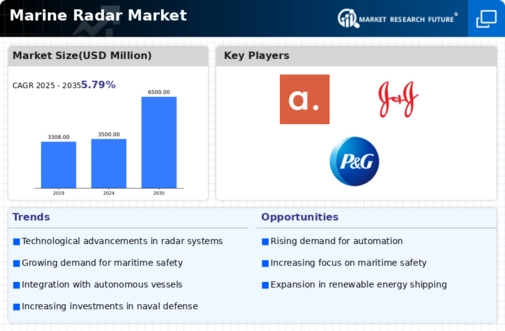Top Industry Leaders in the Marine Radar Market

The key players in the global marine radar market::
Lockheed Martin Corporation (US)
Northrop Grumman Corporation (US)
FURUNO ELECTRIC CO.LTD. (Japan)
Raytheon Company (US)
Saab AB (Sweden)
BAE Systems (UK)
Garmin Ltd (US)
FLIR Systems, Inc. (US)
Kongsberg Group (Sweden)
Alphatron Marine B.V. (The Netherlands)
Strategies Adopted
Industry news within the marine radar market reflects ongoing trends, regulatory changes, and the sector's response to the evolving needs of the maritime community. News related to successful radar installations, collaborations with shipbuilders, and advancements in software capabilities showcase efforts to enhance system performance and operational efficiency. Moreover, developments in radar technologies, such as the introduction of solid-state radar systems, are frequently covered in industry news, reflecting the industry's commitment to staying at the forefront of maritime technology.
Current investment trends in the marine radar industry underscore a dual focus on research and development and strategic partnerships. Key players are directing investments towards improving radar sensitivity, exploring new applications for maritime surveillance, and collaborating with ship operators for system customization. Investments in digital infrastructure, cybersecurity measures, and compliance with international maritime regulations are prevalent, reflecting the industry's adaptation to the growing emphasis on safety and security at sea. Additionally, strategic investments in acquisitions and partnerships aim to strengthen market presence and enhance the overall capabilities of marine radar providers.
Emerging Companies
As the maritime industry continues to evolve, new and emerging companies are entering the marine radar market, contributing to the advancement of radar technology for enhanced navigation and safety at sea. Start-ups such as Terma A/S, JRC/Alphatron Marine, and Intellian Technologies are gaining recognition by providing specialized radar solutions and addressing specific needs, such as small vessel navigation and situational awareness. These companies often leverage research and development capabilities to introduce cutting-edge technologies, including compact radar systems, digital signal processing, and integration with other navigation systems. The industry is witnessing a trend towards the integration of Artificial Intelligence (AI) for improved radar data analysis and decision-making
The overall competitive scenario in the marine radar market is characterized by established brands and dynamic newcomers, each navigating the industry with distinct strategies. Market share analysis considers factors such as radar system reliability, detection capabilities, and adaptability to various maritime scenarios. The industry's responsiveness to technological advancements, regulatory changes, and the integration of AI further shapes competitiveness. As the maritime sector increasingly recognizes the critical role of advanced radar systems in ensuring safe navigation and maritime security, the market is poised for continued growth. Companies in this sector are striving to balance innovation, quality, and affordability to maintain a competitive edge in a complex and rapidly evolving maritime technology landscape.
Recent News
Furuno Electric Co., Ltd. (Japan):
Launch of FARSCOPE Series: In October 2023, Furuno unveiled its next-generation FARSCOPE series of radars, featuring cutting-edge technology like solid-state transceivers for superior target detection and resolution, even in challenging weather conditions.
Focus on Artificial Intelligence: Furuno actively integrates AI algorithms into its radar systems for enhanced target identification and tracking. This can be particularly valuable for collision avoidance and situational awareness.
JRC (Japan Radio Company):
JRC JANUS Radar Development: JRC is focused on developing its JANUS radar series, known for its compact size and high-performance capabilities. These radars are well-suited for smaller vessels and recreational boats seeking advanced radar technology.
Cybersecurity Enhancements: JRC prioritizes cybersecurity in its radar systems, implementing robust protections against cyberattacks and unauthorized access to critical data.
Raytheon Technologies (USA):
G-Series Radar Expansion: Raytheon continues expanding its G-Series radar range with new variants catering to diverse vessel types and applications. These radars offer advanced features like target tracking, weather overlay, and collision avoidance alarms.
Integrated Navigation Systems: Raytheon integrates its radars with its navigation systems, creating a comprehensive suite of tools for enhanced voyage management and safe navigation.
Kelvin Hughes (UK):
Sharkeye Radar Enhancements: Kelvin Hughes recently upgraded its popular Sharkeye radar series with improved target discrimination capabilities and clutter reduction algorithms. This makes it easier for crews to identify real threats amidst background noise.
Emphasis on User Experience: Kelvin Hughes prioritizes user-friendly interfaces and intuitive controls in its radar systems, making them easy to operate even for less experienced users.
Thales Group (France):
CaptainStar Radar Innovation: Thales continues to innovate with its CaptainStar radar range, featuring advanced features like automatic target tracking and route optimization. This technology can help improve operational efficiency and fuel savings for vessels.
Focus on Long-Range Detection: Thales focuses on developing radars with exceptional long-range detection capabilities, crucial for large vessels and coastal surveillance applications.


